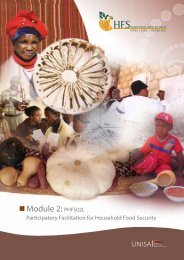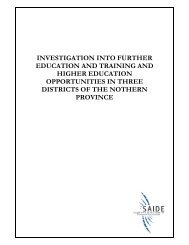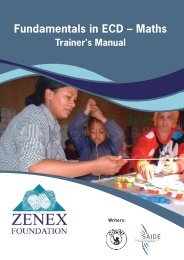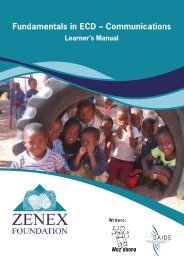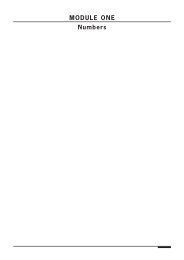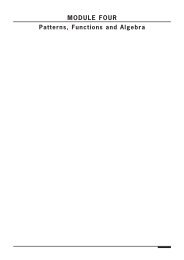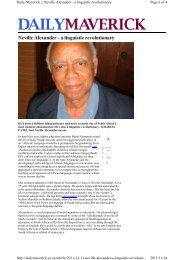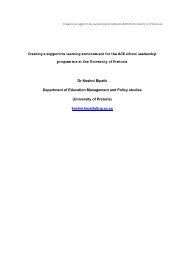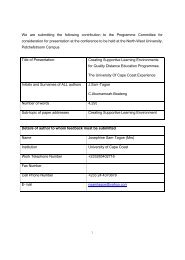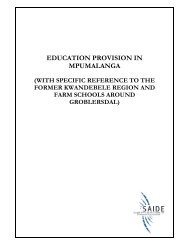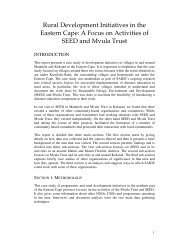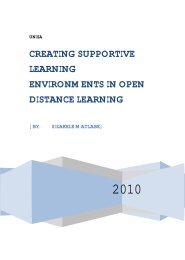Fundamentals in ECD - South African Institute for Distance Education
Fundamentals in ECD - South African Institute for Distance Education
Fundamentals in ECD - South African Institute for Distance Education
Create successful ePaper yourself
Turn your PDF publications into a flip-book with our unique Google optimized e-Paper software.
Introduction5. Projections or predictions are made <strong>in</strong> a manner that is consistent with thedisplay.6. The <strong>in</strong><strong>for</strong>mation is analyzed to determ<strong>in</strong>e and report on the validity of datacollection methods, <strong>for</strong>ms of display and projections that are made.7. Communication of f<strong>in</strong>d<strong>in</strong>gs is clear, consistent with the display and makes useof accepted term<strong>in</strong>ology.SO5:Demonstrate understand<strong>in</strong>g of the concept of chance and calculate simpleprobabilities. (Limited to systematic count<strong>in</strong>g strategies.)1. Situations are identified <strong>in</strong> which chance arises.2. Simple probabilities are determ<strong>in</strong>ed.3. Statements of chance are correctly <strong>in</strong>terpreted.4. The number of comb<strong>in</strong>ations and the probability of a particular event aredeterm<strong>in</strong>ed.5. Probabilities are used to address simple real or simulated problems.2. Unit Standard 7449Critically analyze how mathematics is used <strong>in</strong> social, political and economicrelationsSpecific Outcomes and Assessment Criteria:SO1:Critically analyze the use of mathematical language and relationships <strong>in</strong> theworkplace. (Wage negotiations, salary <strong>in</strong>creases, and productivity as a ratio.)1. The ways <strong>in</strong> which mathematics is used <strong>in</strong> the workplace are described.(Percentage, graphs, differences, ratio and proportion.)2. Ways <strong>in</strong> which mathematical relationships and language can be used torepresent particular perspectives are described. (Different <strong>for</strong>ms ofcomparisons such as differences versus ratio. Manipulation of graphs throughchoice of graph, scale of axes and nature of axes. Use of different averages:mean, median, mode. More than one perspective is to be described.)SO2:Critically analyze the use of mathematical language and relationships <strong>in</strong> theeconomy. (Budget<strong>in</strong>g, banks: <strong>in</strong>terest rates, mortgage, service charges; fuel prices;pensions; <strong>in</strong>flation; value of the rand and exchange rates.)1. The ways <strong>in</strong> which mathematics is used is described. (%, graphs, differences,ratio and proportion.)2. Ways <strong>in</strong> which mathematical relationships and language can be used torepresent particular perspectives are described. (Different <strong>for</strong>ms ofcomparisons such as differences versus ratio. Manipulation of graphs throughchoice of graph, scale of axes and nature of axes. Use of different averages:mean, median, and mode. More than one perspective to be described.)3. The impact of economic changes on the <strong>in</strong>dividual is described.xv



